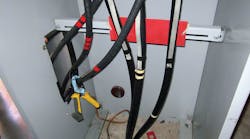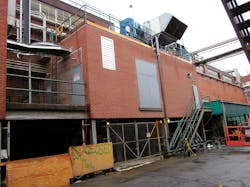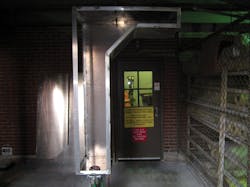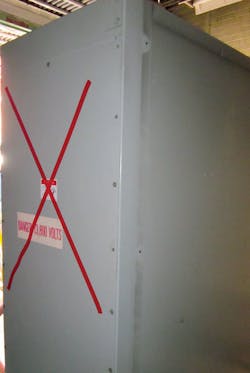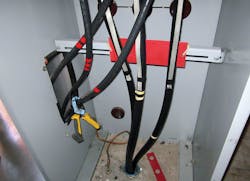One of the most common reasons for marriage failure today is the breakdown of basic communications. The same holds true for construction and maintenance workers. Words spoken on the job with a specific intent can often be misconstrued to mean something entirely different — a situation that can ultimately be a recipe for disaster. That was definitely the case at a major chemical manufacturing facility when an unqualified electrical helper working for an outside electrical contracting firm was asked to perform a task he didn’t fully understand.
The job at hand on that fateful day was to remove some temporary medium-voltage (MV) cabling and rigid conduit that extended from the old MV load break switch (which was being used as a splice box) to a new load break switch — and to install a new junction box. The crew performing the installation, who was hired by the manufacturing facility as an electrical contractor, had been working on this job for several weeks, replacing the aging electrical distribution equipment. This involved replacing the old substation located in Building 12B (Photo 1) with a new one in Building 12C (Photo 2).
The scene
The distribution system was configured so that power flowed from an MV breaker (located in another building) to old load break switch [36-3] (which was basically gutted and used for a splice box) in old substation Bldg 12B. Temporary MV cable was installed to power a new load break switch [36-4] in Bldg 12C (green cable), as shown in Fig. 1 (click here to see Fig. 1). Company electricians (in-house employees who worked for the chemical plant) placed this circuit under lock and tag (LOTO) the morning of the incident.
Contractor employees were removing the temporary cabling and conduit between old load break switch [36-3] and new load break switch [36-4] to install a new junction box below the substations in order to provide a permanent feed for the left half of the new substation in Bldg 12C. Similarly, power flowed from a different MV breaker (also in another building) to the other old load break switch [46-3] (which was also just used as a splice point), and then temporary cable was run to new load break switch [46-4] (red cable). This circuit was energized, and the new double-ended substation in Bldg 12C was configured such that the tie breaker was closed, allowing the entire line-up to be powered by this circuit.
The contractor crew acquired a safe work permit and hot work permit from the company’s area maintenance coordinator first thing that morning. They also conducted a safety task assessment (STA). In fact, the contractor used the STA as a means of pre-job safety assessment — a method that was typically very effective in identifying hazards and either eliminating or mitigating them. However, on this particular morning, the STA did not include any specific information about cutting or removing cables. Instead, it concentrated on installation of the junction box (Photo 3). While waiting for the job setup to be completed, a member of the contractor crew (who we will refer to as the ‘contractor electrical helper’) left the building to help move cable reels to another building.
Company electricians completed the isolation of the load break switch by racking out and performing LOTO on the MV breaker in another building. They also peeled the red tape “X” off of the back of the new load break switch that had been isolated in the new substation. (This “X” is used to alert people that this part of the substation is energized. Because this load break switch had been de-energized and placed under LOTO, the “X” was removed.) Company electricians then removed the back panels of the locked-out new load break switch [36-4], and unbolted the cable terminations after verifying that the circuit parts were de-energized using voltage test equipment. At this point, they told the electrical contractor the circuit had been de-energized/locked out, and left the area. Contractor personnel placed their locks on the lock box for the circuit.
The accident
Contractor employees began cutting the conduits and cabling below the de-energized old load break switch [36-3] in Bldg 12B. The contractor lead electrician asked the electrical helper to get his ratchet cable cutters, “go to the far load break, and cut the 4/0 cables.” (He was being asked to cut the MV terminators off of the cables in the back of the locked-out load break switch [36-4] so that they would pull out of the conduit easily.) The contractor crew, including the lead electrician, began wiping lubricant off of the cables in anticipation of pulling them out of the conduit.
The helper promptly went up the south stairway of Bldg 12B and entered the old substation room (Fig. 2). He passed by de-energized load break switch [36-3] (which had the wires hanging out and the back taken off), noticed the door leaning up against the back wall, and continued to far load break switch [46-3] in, which was energized. He noticed that this switch was locked and tagged in the off position. He also saw the red tape “X” on this load break switch (Photo 4) but made the incorrect assumption that this device was de-energized. The helper took a battery-powered drill and removed the bolts from the back cover from the energized load break switch and placed the cover to the side. When he began to cut the cable in the back of the load break switch, he heard a loud “pop” and saw a flash. Realizing something was very wrong, he went to the south stairway to tell the contractor’s lead electrician that there might be a problem. A problem it was, indeed. Company operations personnel quickly showed up asking what had happened, considering that a significant portion of the chemical manufacturing facility had lost power when this fault occurred. Despite the disruption and downtime that followed, the miraculous thing was that the helper walked away from the incident without a scratch.
Investigation and analysis
One positive result of this near-miss was that the ground fault detection and relaying system on the MV power circuit breaker was tested and proved to work as designed. The protection system detected the phase-to-ground fault, which resulted from the cable cutters slicing through the copper shield on the 13.8kV cable and penetrating the inner conductor. The circuit breaker opened quickly, removing power from the fault and preventing a large arc flash event.
The investigation uncovered some rather unsettling facts that ultimately contributed to this safety near-miss.
• Although he was considered to be a good worker and generally did his best to perform tasks correctly, the helper was not a qualified electrical worker as defined by NFPA 70E (“one who has skills and knowledge relating to the construction and operation of the electrical equipment and installations and has received safety training to recognize and avoid the hazards involved”). During the investigation, the helper’s answers to some basic questions about the new substation installation clearly demonstrated he did not fully understand the technical aspects of this job.
• The electrical contracting firm’s employees had worked at the chemical manufacturing site for many years, so they clearly understood both site policies and their own contracting firm’s requirements for participating in the LOTO /hand-over of the de-energized circuits, yet they did not do so on this job. The company electricians performed the circuit lock-out, but there was no verification by the contractor employees — and virtually no discussion about how the lock-out had been performed. They just took the electrician’s word for it that everything had been isolated, locked out, and de-energized.
• The pre-job safety review performed by the contracting crew the morning of the incident was not executed properly. The STA focused on the “big job” rather than specific issues and safety hazards of the task at hand, which was to remove the old cables and conduit, install the junction box and new conduit, and then install the new cabling.
• Clearly, the instructions given by the electrical contractor’s lead electrician to the helper were inadequate. “Go to the far load break, and cut the 4/0 cables,” he was told. During the investigation, it became apparent that the lead electrician intended for the helper to go up the north stairway adjacent to Bldg 12C, enter the new substation room, go to the far load break switch [36-4] in that room (which was de-energized and under LOTO), and cut the terminators off of the shielded cable. The helper, however, went up the south stairway next to Bldg 12B, entered the old substation room, and went to the far load break switch in that room [46-3] (which was energized) to make the cut (Fig. 2). In essence, the helper did exactly what he was told to do! In retrospect, it was also determined that the lead electrician did not fully understand what tasks he should assign to the helper without direct supervision. The pair had worked together in the same crew for many months, which may have lulled the lead electrician into a sense of complacency concerning the helper’s understanding of instructions.
There was a lock and tag on the front of load break switch [46-3] — left over from the removal of the old substation equipment — where the cut was made (Photo 5). In actuality, this load break switch was only being used as a splice box. Thus, the lock and tag were meaningless. However, when the helper saw the lock and tag, it further convinced him that it was okay to remove the back from this load break switch — a decision that substantiates the fact that he should not have been considered a “qualified” electrical worker.
At this company site, there were high expectations concerning the wearing of arc-rated clothing whenever an arc flash hazard exists. However, no one had given adequate consideration to the concern of cutting into existing cables — especially shielded MV cables — that were installed in the field. Because of the difficulty of testing shielded cables to determine whether they are energized or not, the assumption of “energized until proven otherwise” should always prevail, and adequate arc-rated PPE should be worn until the first cut is made.
The taped red “X” system also proved woefully inadequate as a method to inform workers of energized parts. A better system — one that is NFPA 70E-compliant — should have been used.
Lessons learned
There were many action items that resulted from the incident investigation, all of which made improvements to the company’s electrical safety program:
• The company group responsible for contractor management was asked to ensure that outside contractors both define and understand the qualifications for performing electrical work — and that those doing so were adequately trained and fully competent. The role of helpers also needed to be clarified.
• The site’s Safe Practices Manual, which contains the electrical safety program, was re-worded to require that all parties working on the job be involved in the “absence of voltage” check after LOTO is performed.
• The company contractor management group was asked to stress to all site contractors the proper use of the pre-job safety assessment, which must be detailed enough and specific to the tasks to be performed that day. All those who are involved in the work must participate in this assessment.
• The company crew responsible for electrical distribution was assigned the task of implementing new minimum PPE requirements for making cuts on cables that have been previously energized.
• Finally, the company electrical crew responsible for working on distribution equipment developed an NFPA 70E-compliant hazard identification process to replace the red tape “X” system. This new process was rolled out to all parties involved, including outside contractors.
At the end of this case, all parties involved learned that improper communications is an ongoing issue that is not easily resolved. The miscommunication and incorrect interpretation that started the dangerous chain of events — and led to a near-miss in this case — is a lesson for all of us. Only by stressing safety above all else and at all times can we hope to keep employees safe.
Huddleston is a licensed professional engineer in Tennessee and an electrical safety engineer at Eastman Chemical Co., Kingsport, Tenn. He can be reached at [email protected].
